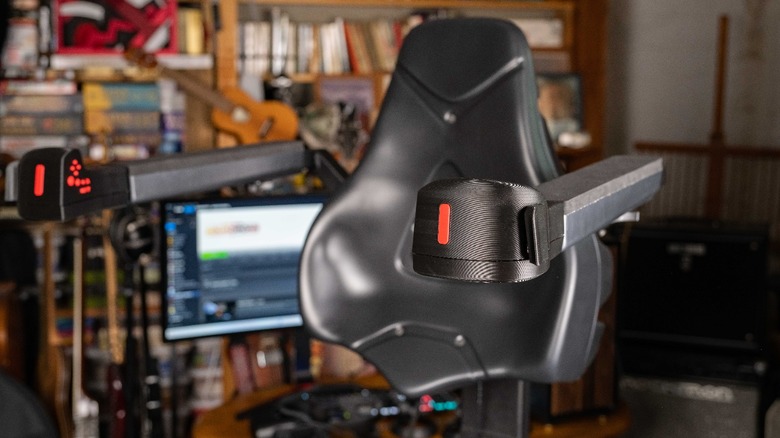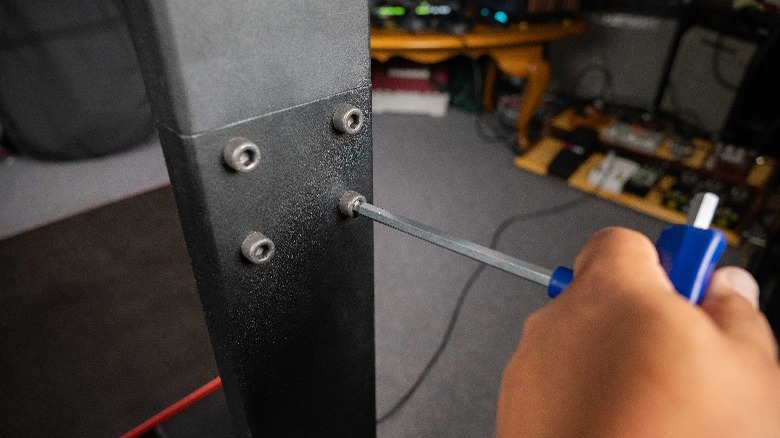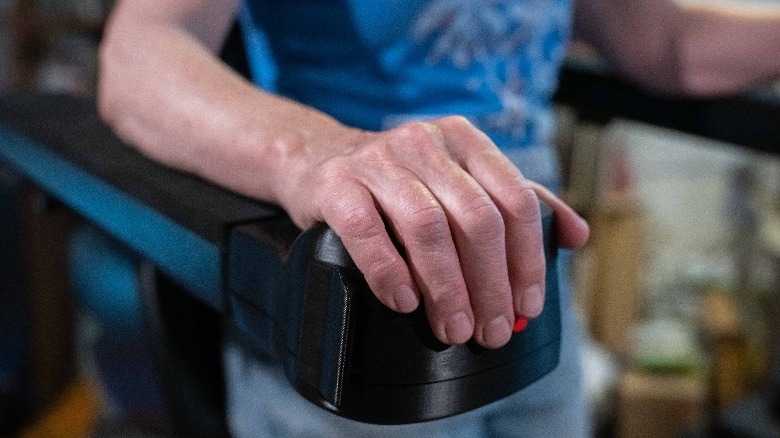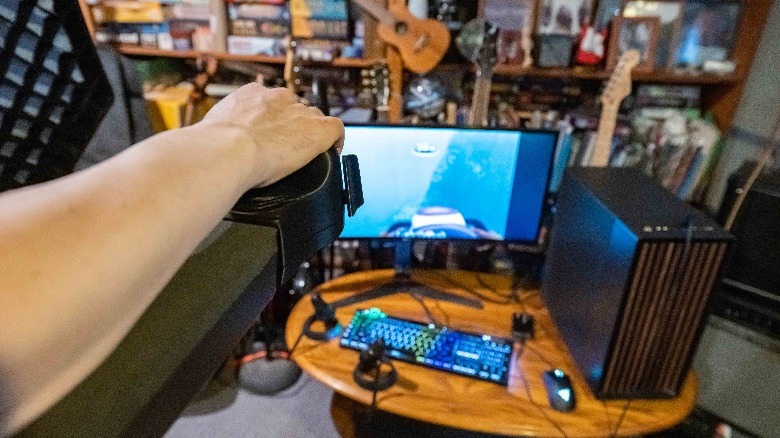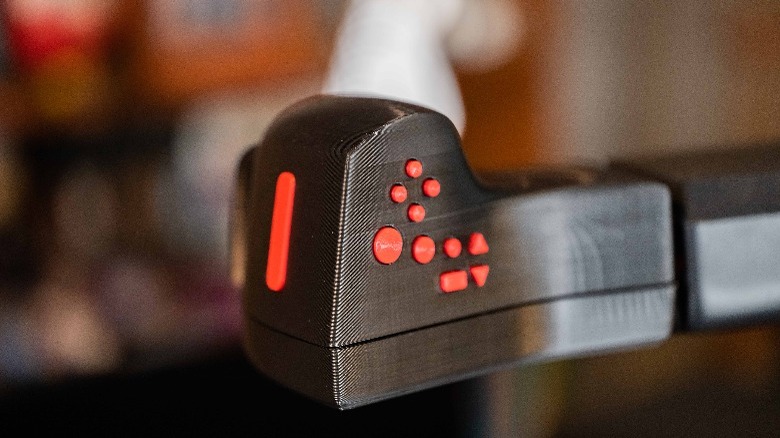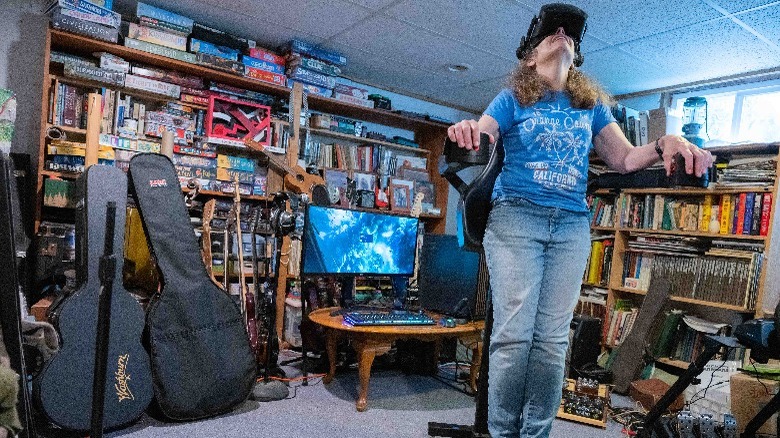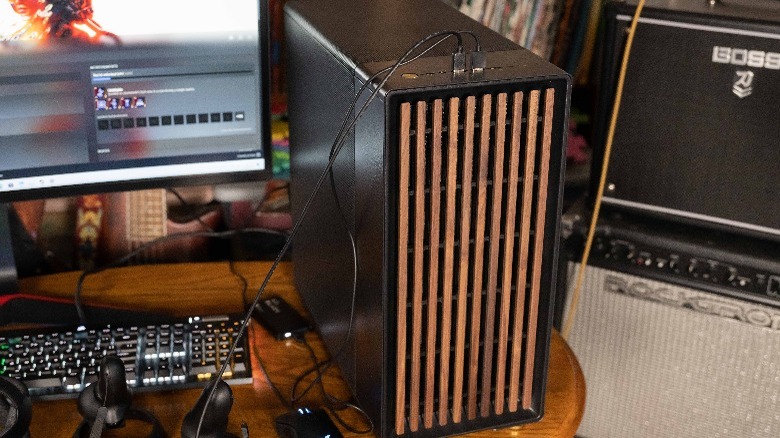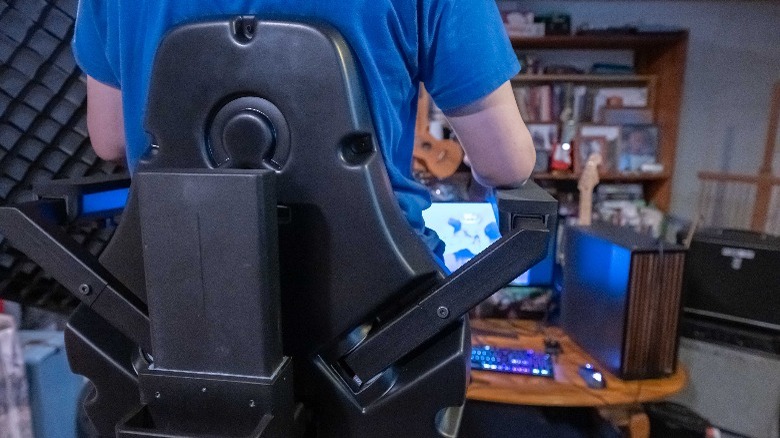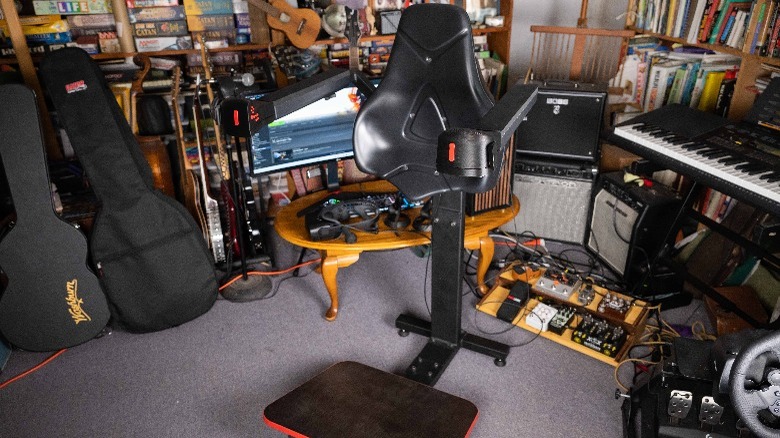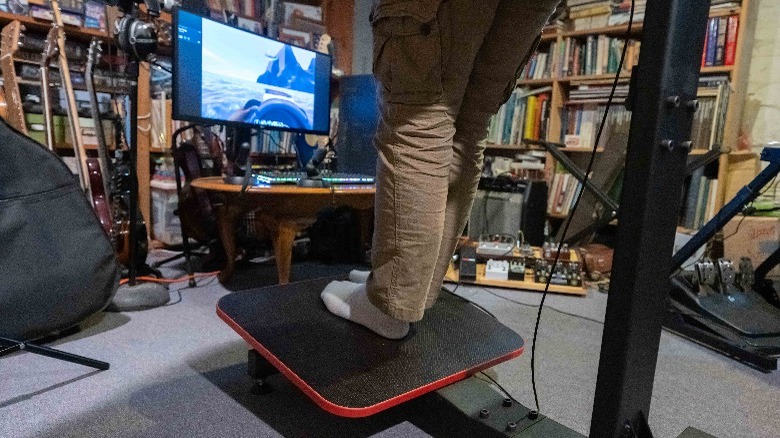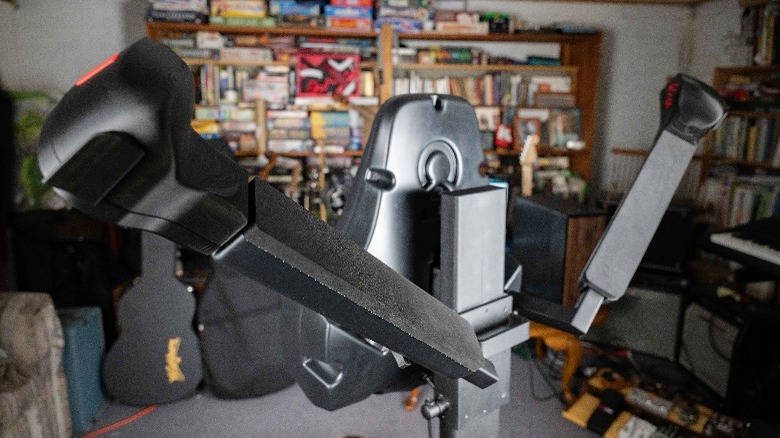Neurosync C-Infinity Review: An Effective Fix For VR's Greatest Weakness
- Design and controls make VR accessible by reducing nausea
- Robust and durable
- Comfortable for long periods of time
- Highly adjustable to fit different body types
- Requires less room to play VR titles than with motion controls
- Heavy weight requires two people to assemble
- Steep learning curve
- Controller inconsistency and unusual button layout
- Build quality is somewhat unpolished
- Expensive
Virtual reality gaming is an exciting genre, but one that suffers from some major hurdles when it comes to accessibility, several of which the Nurosync C-infinity aims to solve. Many people unfortunately find virtual reality practically unusable due to the nausea they experience while using VR devices. The C-infinity employs some clever tricks to counter this, and in doing so could unlock the technology for a lot of people who would otherwise be unable to use it. Secondly, the C-infinity is intended to permit VR gameplay without the need for a large open play space.
If this large, standing chair can pull this off and offer an exciting virtual reality experience free of nausea and in a relatively compact space, then it could dramatically expand the appeal of virtual reality gaming. However, there are also some aspects of the C-infinity which could limit its potential market.
Nuerosync provided us with a sample of the C-infinity to test and review.
Some assembly required
The Neurosync C-Infinity arrives disassembled, and it's up to the end user to put it together. It was also quite a handful to take delivery of, as it showed up in two gigantic boxes which were around 80 lbs each. Our local shippers had difficulty handling the packages, and just getting them in the door required two people. Be aware that if your local delivery person is unwilling to handle the packages you may need to pick them up at the shippers depot in your area, which was the situation we encountered.
Actually assembling it was a largely straightforward process, with the pieces fitting together in a logical manner. The only stumbling point for us was which screws went where, but by carefully rewatching the instructional setup video we were quickly able to correct the mistake.
It's important to note that it's absolutely essential that two reasonably fit people be on hand to assemble the C-Infinity. The stresses it needs to withstand require it to be built from strong materials, and so by necessity the components are quite heavy. The upper portions of the device in particular need one person to hold them in place while another connects wires and screws in bolts. Due to the awkwardness and weight, it's not a task which should be attempted by a lone individual.
The importance of calibration and learning the controls
In order to achieve the nausea-free experience promised by Neurosync, you'll want to calibrate the responsiveness of its controls. First, you'll need to become acquainted with the unusual methods for controlling the device. It's particularly important to get the turning speed right, which is most easily calibrated by having the user turn at their normal rate and then matching the turning rate of the C-infinity with that speed. The issue here is that for each game you'll need to recalibrate, which is something of a pain, and what the system needs is some kind of software to save controller calibration profiles for different games and users.
A lot of research and testing has gone into the control scheme of the C-Infinity. To turn, you swing your body to one side or the other, but you shouldn't use your arms to accomplish this. To go forward, one must pull gently on the controller, and push backward to reverse, but be sure not to pull upwards on the arms. Side-to-side motion (strafing) is controlled with the paddles on either arm. The push/pull motion can feel very counterintuitive at first and takes some time to get used to.
The C-Infinity is all about minimizing effort on the part of the user, both to reduce fatigue and to heighten immersion by making movement feel more natural. Practice is necessary to get to grips with these novel controls, which are unlike anything else we've ever used.
Universal compatibility
The C-Infinity is fundamentally a standard video game controller on a mechanical level. Your headset is essentially the joystick controlling the view, while the motion sensors in the C-Infinity are the directional joystick, and the buttons on either arm all map to what you'd find on an Xbox controller. What this means is that the device should be able to work with the native controls of most non-VR games with VR functionality modded in, making the experience of playing something like "Cyberpunk 2077" in virtual reality much more feasible.
Getting used to the button layout definitely requires building up some muscle memory, as while they are representative of an Xbox style controller, the layout is definitely unusual. For example, the two big buttons on the controller are actually mapped to the thumbstick clicks. This makes sense when you realize that in many games you click the left stick to aim and the right stick to run. All the buttons are arrayed and mapped as they are for a reason, but if you want you can always remap them in the game in some manner that works better for you.
Not the best buttons
In practice, we did run into some problems with control responsiveness, particularly when using in-game menus, and the buttons are rather roughly made. The device would be greatly improved by more robust and distinct buttons, some of which aren't currently even mapped to anything. When you first put your hands on the controls, nothing really makes sense.
The buttons all feel very similar to the touch, and the paddles for strafing confused everyone who we had testing the C-infinity. Over time, everyone we had testing this device got used to the controls, but they are hardly ideal. Having larger buttons with more distinct textures would be a major improvement, and our testers often wished for a simple joystick as they learned the way this new controller worked.
A joystick would be particularly helpful for steering vehicles, which feels somewhat unnatural with the controls as they currently are. One of the people we had testing the C-infinity found that the way cars are controlled using buttons in "Cyberpunk 2077" actually made her nauseous, but when she exited the car and was running down the street using the push-pull motions, the nausea abated. With this in mind, adding a joystick to the device would be very helpful in some situations.
Immersive gameplay and efficacy at preventing nausea
Two of the people we had test the C-Infinity struggle with extreme motion sickness in virtual reality. For them VR is basically unusable, and typically results in headaches and nausea which take hours to dissipate. With the C-infinity, they were immediately able to jump into "Subnautica" and play without experiencing nausea throughout most of their playtime. For one player, however, everything went fine until they got stuck in a cave, whereupon the struggle to escape caused some symptoms of nausea, primarily a headache that lasted afterwards. We later realized that this was in part due to improper calibration of the turning speed, but mostly it was the disorientation of the confined cave environment that broke the immersive properties of the C-Infinity.
The other test subject found that reversing or swimming upwards in "Subnautica" brought about nausea symptoms. Nuerosync recommends that people who experience nausea in VR limit themselves to 3-5 minutes the first time using the C-Infinity, and increase that period over a number of sessions.
When properly calibrated, and with practice, the C-Infinity seems to fulfill its promise of nausea free virtual reality, and makes navigation in games far more natural than with a traditional controller. Getting the controls just right for each game can be a challenge, but the experience this device provides when you get everything to sync up perfectly is truly unique.
The importance of using an adequate gaming PC
We were fortunate to have the Cobratype Elevate Legend Limited gaming PC on hand while testing the Neurosync C-Infinity. In our recent review, this proved to be a powerful and practically flawless PC, and you really need that kind of performance when you're trying to play graphically intensive games at high framerates in virtual reality. This is particularly vital when you're talking about creating a nausea-free experience, as maintaining high, consistent frame rates and resolution is important to preventing nausea. The more convinced your brain is that what it's seeing is real, the less it will rebel against that illusion.
The Cobratype Elevate was able to run everything we threw at it with maximum graphical fidelity and in as many frames per second as our HP Reverb G2 headset could render, even in "Cyberpunk 2077" with raytracing enabled. While you can use less powerful hardware, a high-powered gaming PC can help overcome some of the challenges encountered with poorly optimized VR mods for non-VR games should they arise.
Here's how this thing works
The Neurosync C-infinity has some very real and complex scientific research behind its design, and a lot of development went into making it a reality. When you move in real life, you're not only sensing the world and your motion with your eyes but also with the vestibular system. The vestibular system detects the movement and position of your head in space using the inner ear. This means that if your eyes see motion, but your vestibular system doesn't, it may cause your brain to ring alarm bells. This is known as vestibular disconnect, and its consequence is the feeling of nausea.
When you apply light pressure to move forward or backward with your hands using the C-infinity, it sends signals to the somatosensory cortex, which is located just behind the motor cortex in the brain. The overlap between these areas of the brain allows the input into the somatosensory cortex to trick the motor cortex into thinking it's in motion. Paired with the visual input from a virtual reality headset, this significantly reduces vestibular disconnect.
While there are certainly some big words there, it's really quite elegant in the simplicity of the solution. Essentially, by exerting slight pressure with your hands, you are able to fool your brain, since you are stimulating the correct area of the brain which senses motion.
Uses outside of games
Let's face it, the C-Infinity is a beefy piece of hardware, so it's worth considering what uses it might have outside of VR gaming. Fortunately, the device is comfortable enough that it can act as a rather unusual chair. The obvious implementation is as a chair for a standing desk, thus increasing the comfort over long periods of time using such desks while maintaining the health benefits of a standing desk. This works well enough, and the arms fold back behind the C-infinity to free up the space in front of the device. However, you will need a desk that can be pushed back from the C-Infinity when you want to use it for gaming, as the C-infinity itself is rather difficult to move around.
With this in mind, a great upgrade to the C-infinity would be a fitted, removable table so that you could easily place a keyboard and mouse on it. Such a setup paired with a large television could make a really great entertainment and productivity rig, and it's certainly an accessory that I'd like to see Neruosync produce.
You could also use the C-infinity with a VR headset as a comfortable standing solution for a virtual office workspace. Paired with the Apple Vision Pro, the result could be a very ergonomic and compact home office setup.
A serious investment
The Neurosync C-Infinity is not a small purchase, and in fact it'll set you back as much as a high end VR headset. The full retail cost of the C-Infinity will be around $2000, though currently it's available to pre-order for $950 less, a price which Neurosync says will be increased gradually over time up to the aforementioned MSRP.
Regardless of whether we're talking about a discounted price point or the full price, the C-infinity is too large a purchase to make as an impulse buy. However, it's also not an unfair price given the immense solidity of the device. Developing, manufacturing, and shipping such a large contraption isn't cheap, and the cost of the C-infinity reflects the expense of production and delivery. With that said, it's also very much a limiting factor of the mass appeal of the C-infinity. The price tag alone makes this very much a device for enthusiasts with deep pockets.
Conclusion
The Neurosync C-Infinity is a difficult thing to judge, and whether or not it can be recommended for you is going to depend on a number of factors. The enormous weight and size is one consideration, as it's physically challenging to set up, and while it doesn't need as much room as roomscale VR, it is a large piece of furniture that's difficult to move once assembled. The cost is another factor, as it will set you back as much as a gaming PC or high-end VR headset. Thirdly, it requires a lot of calibration and game modding to function in most games, so you either need to know how to do that or be willing to learn.
However, for the right people, none of these considerations will be deal breakers. The efficacy of the C-Infinity at eliminating nausea is frankly incredible, and effectively balances the scale against all of the significant cons associated with the device. For a PC gaming enthusiast who is unable to play virtual reality games because of nausea, the money, and effort may be worth it to finally be able to enjoy immersive experiences in VR. Watching the people in my life who are particularly susceptible to nausea use the C-infinity and see their faces light up as they played showed me that there is something great here.
If nothing else, the Neurosync C-Infinity is a huge technological leap forward for VR, solving one of the greatest weaknesses of the medium. This device's Kickstarter is up and running starting on January 23, 2023.
